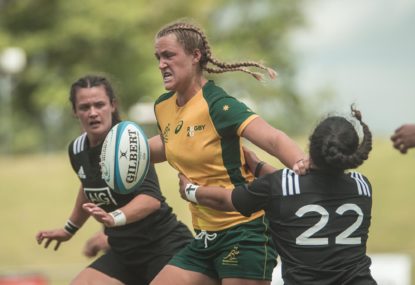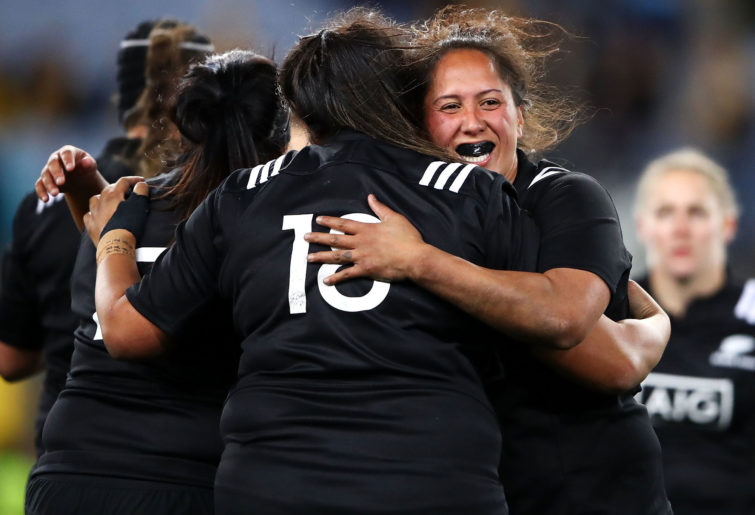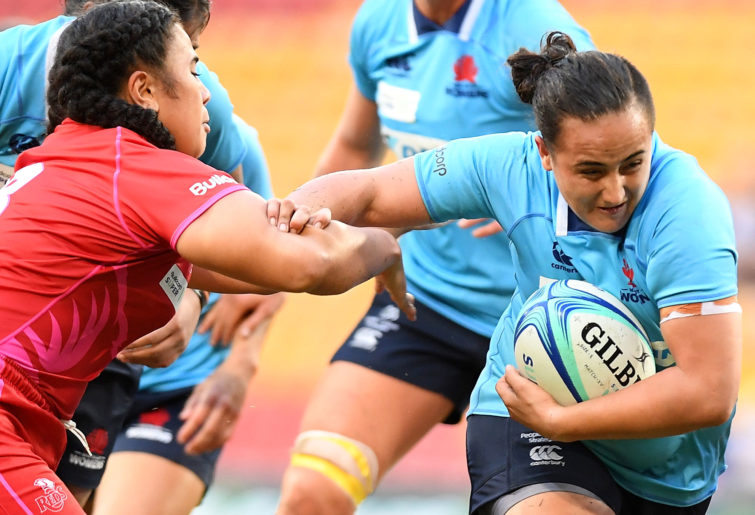WATCH: Individual brilliance from Hunter Paisami sets up Tim Ryan's first SRP try
The Queensland centre created the try out of nowhere with a perfect chip and chase to find the flying winger to run away and…
Opinion

In a 2021 interview, Cate Sexton, NZR Head of Women’s Rugby, stated, “Next year is absolutely huge for women’s rugby and this [Super Rugby Aupiki] competition will be the perfect showcase to kick things off and get the rugby public engaged in women’s rugby”.
While it delivered on being a showcase, “rising Covid cases and a condensed schedule meant it never quite lived up to its promise”.
Super Rugby Aupiki finished on Sunday, 20th March, won by a very impressive Chiefs Manawa side. The four competing teams played three matches over two weeks (matches on Thursday, Tuesday, and Sunday).
Why so short? Well, that wasn’t the initial intention. Unfortunately, the tournament was truncated due to Covid.
Originally, the competition was supposed to be over four weekends with “home-and-away fixtures for each team” with the top two teams battling it out in a final scheduled for 26th March.
However, through no fault of NZR, the competition didn’t end up living up to its name – ‘the ascent to the upper most realm’, and while we saw some very good rugby, crowning a winner after three matches, had an anticlimactic feel: “If we really want Aupiki to be the ascent, and not a continuation of the slow uphill climb, it deserves better than this. And to raise that bar, we must ask for more and not be thought of as poor sports for doing so”.
There was great hope attached to the inaugural competition. According to Chris Ledrum, NZR General Manager of Professional Rugby and Performance, “This year is going to be like nothing we’ve seen before when it comes to the women’s game and Super Rugby Aupiki is a great way to get things underway”.
But with the preseason Game of 3 Halves cancelled due to a Covid outbreak in the Hurricanes Poua squad, the lone preseason match between Chiefs Manawa and Matatū was an ominous sign. While the competition was being touted as a pathway “for women in our game”, the relocation of the squads to Taupō may have ensured the competition proceeded, but the ensuing three rounds only resulted in 5 matches.
Better than nothing but considering “The equivalent men’s competition has more than 90 matches” it’s a reminder of the unequal playing field between the genders.
In saying that, nothing can take away from the Chiefs Manawa who were deserved winners of the competition with 14 points – 8 points ahead of both the Hurricanes Poua and Blues Women.

Women’s rugby faces many disadvantages, including a lack of match time. (Photo by Mark Kolbe/Getty Images)
However, while the condensed version of the inaugural competition is merely a casualty of the times in which we live, one would think more contingency plans would be in place to provide the women the much-needed match time required for their buildup to the RWC.
After all, “The last time these women played was either the Farah Palmer Cup in October or the infamous Northern tour in November”. The competition, one “that was long overdue felt rushed”, which is a shame considering the season ahead. After all, for the first time, the Black Ferns will be defending their world title at home later in the year.
They deserve to have no stone unturned in their preparation.
However, the issue isn’t the Covid-created changes per se, it’s the difference in the response to said changes between Super Rugby Aupiki and that of the men’s competition in 2020 and 2021.
In Super Rugby 2020, the tournament finished after Round 7, with the final match being played on Sunday, 15th March. Super Rugby Aotearoa started on Saturday, 13th June – just 13 weeks later, during the still-early stages of the pandemic (Tribe).
The competition involved “all five of the country’s Super Rugby clubs playing in a round-robin format, with 20 matches played over a 10-week period to decide the winner”.
Only one match was cancelled due to Auckland being in Alert Level 3. The following year, 2021, saw both Australia and New Zealand continue with their domestic brand of Super Rugby until 14th May when Super Rugby Trans-Tasman started (Tribe).
There was a lot of domestic rugby available for the men’s teams before the 2020 Tri-Nations and the 2021 Rugby Championship and End of Year Tour.
In comparison, during the same timeframe the women played 7 rounds and the playoffs of the Farah Palmer Cup (39 matches), along with a Probables vs Possibles trial. No Super Rugby.
In 2021, 7 rounds of the Farah Palmer Cup were played leading up to the SFs and Finals (a total of 37 matches), with four matches being cancelled due to Auckland’s Covid restrictions (Tribe). The first ever women’s Super Rugby match in NZ was played on 1st May 2021 between Blues Women and Chiefs Manawa.
This year, the women “were given just two weeks to reshuffle their lives and go into camp fulltime to get this tournament off the ground”. They were “Offered a sign-or-be-replaced ultimatum, with just days to consider what this may mean”.
In addition, “the removal of the final, for which they had been offered a $1200 appearance bonus”, meant that players were “out of pocket”.
Most players took pay cuts during the start of the pandemic, but would the NZRPA allow the male stars of NZ rugby to be “out of pocket” if a finals bonus had been promised?
The slowness of NZR to provide a Women’s Super Rugby competition in New Zealand is quite astounding, especially when considering Australia’s Super W has been going since 2018.
In Australia, Super W managed to play all their five rounds in 2020 (10 matches), only having to cancel the finals (Tribe).
In 2021, the competition expanded from five teams to six with the only matches being cancelled due to the restrictions in Western Australia forcing the Western Force to return home (Tribe). There were still 10 matches played.

Ariana Kaiwai of New South Wales (Photo by Bradley Kanaris/Getty Images)
While the Wallaroos haven’t played a match since the August 17th, 2019, the opportunities provided for the Black Ferns may have been more numerous (two matches in 2020 against a New Zealand Barbarian side and the two matches against both England and France in 2021) but the lack of preparation leading to Northern tour was obvious.
In comparison, in 2020 the Women’s Six Nations played four rounds before matches started being cancelled – a total of 12 matches played. In addition, Scotland played Spain in January and England and France played a two-match series in November.
In 2021, nine matches were played over three rounds and the finals. In addition, France played England in April. In the November window, a total of 15 matches were played, with the Six Nations countries winning all but one of their matches (Canada beat Wales).
The 2022 instalment is due to start this weekend (26th March) (Tribe). With the disparity of game time, it’s no wonder the Black Ferns feared so poorly on their Northern tour!
The lack of preparation for the Black Ferns before the RWC is just not good enough. Considering that, “One in five rugby players in New Zealand are now women, and their numbers are rising”, NZR must provide more opportunities because “the absence until recently of a high-quality professional women’s league in New Zealand prevented Black Ferns players from training and testing themselves as regularly as their overseas rivals, who are fast emerging as credible challengers”.
For Farah Palmer, NZR Vice Chair, the struggle against England and France last year, was due to them having “way more opportunities to play their close neighbours”.
There is no substitution for match time. According to Chiefs Manawa Coach, Allan Bunting, it was great “having the best players around the country all coming together and competing… But now I feel like we’ve had enough preparation just to start the competition”. He believes, “If we played on from this point, you would see an even better quality game”. And that makes perfect sense.
Why is there no Women’s Rugby Championship? Why has Sanzaar continued to neglect the women’s game, when the Women’s Six Nations has been played since 1996? The Farah Palmer Cup is a good competition, but nobody would expect the All Blacks to go into the international season after only playing NPC. If the men get the maximum preparation, why don’t the women?
But the inequality doesn’t end with matches. Players need to be supported salary-wise so they can dedicate the time necessary to be top athletes: “It’s been reported that higher-profile All Blacks can earn as much as a million dollars a season. However, according to Rugby New Zealand, Black Ferns Sevens players earn a base salary of between $45,000 to $90,000 and Black Ferns get a base of only $20,000 to $55,000 per year”.
Of course, the ever-present chorus of ‘they don’t bring is as much revenue’ will perhaps not see a problem with the pay difference, but perhaps pay scales should reflect the general job market and be based on merit: “For decades, the Black Ferns maintained a winning percentage in international test matches of almost 90 percent” in addition to winning “five of the last six World Cups”.
Their record should afford them more. Yes, “more women are being paid to play” but “unless they have a meaningful structure and people who are resourced to support them, there’s still more work to do”.
There has been progress in women’s rugby in New Zealand, but the progress is slow due to “a chronic lack of investment and under-resourcing”.
Game time and salaries aside, another area where the sport is lacking is representation in the upper echelons of management: “The absence of women in head coaching roles for rugby’s newest showpiece has led to claims the sport’s leadership has dropped the ball when it comes to creating pathways for female coaches”. For many, the lack of female coaches in Super Rugby Aupiki, shows that our “rugby bosses have missed an opportunity to promote the off-field talent alongside that on-field”.
This trend is reflected in the Farah Palmer Cup, “with men overwhelmingly occupying the top jobs”. It’s sad, that in 2022, the “Black Ferns have had only one woman coach in over 30 years of internationals”.
But NZR isn’t the only governing body to fall short in that area – The Chairman of World Rugby’s Women’s Advisory Committee is Serge Simon!
Hopefully, Super Rugby Aupiki will expand into a longer competition in the future. Another development that could be easily organised is the expansion of the Super W and Super Rugby Aupiki competitions into a Trans-Tasman competition. So come on NZR, in this instance bigger really is better.
But the major development that’s needed is a Women’s Rugby Championship. It’s disgraceful that women’s rugby in the Southern Hemisphere has no flagship competition. So come on Sanzaar, if you want the SH teams to be competitive, provide the matches.